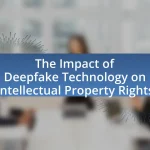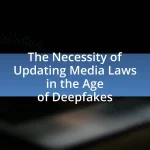The article examines the profound impact of deepfake technology on litigation, highlighting its challenges to evidence verification and witness credibility. It discusses how deepfakes complicate traditional legal frameworks, raising concerns about authenticity in court and the potential for defamation and fraud claims. The piece outlines the legal consequences of deepfake usage, the types of cases likely to involve this technology, and the measures courts are implementing to adapt, including new evidentiary standards and forensic techniques. Additionally, it addresses the role of legal professionals in preparing for deepfake-related cases and the evolving legislative landscape aimed at combating deepfake misuse.
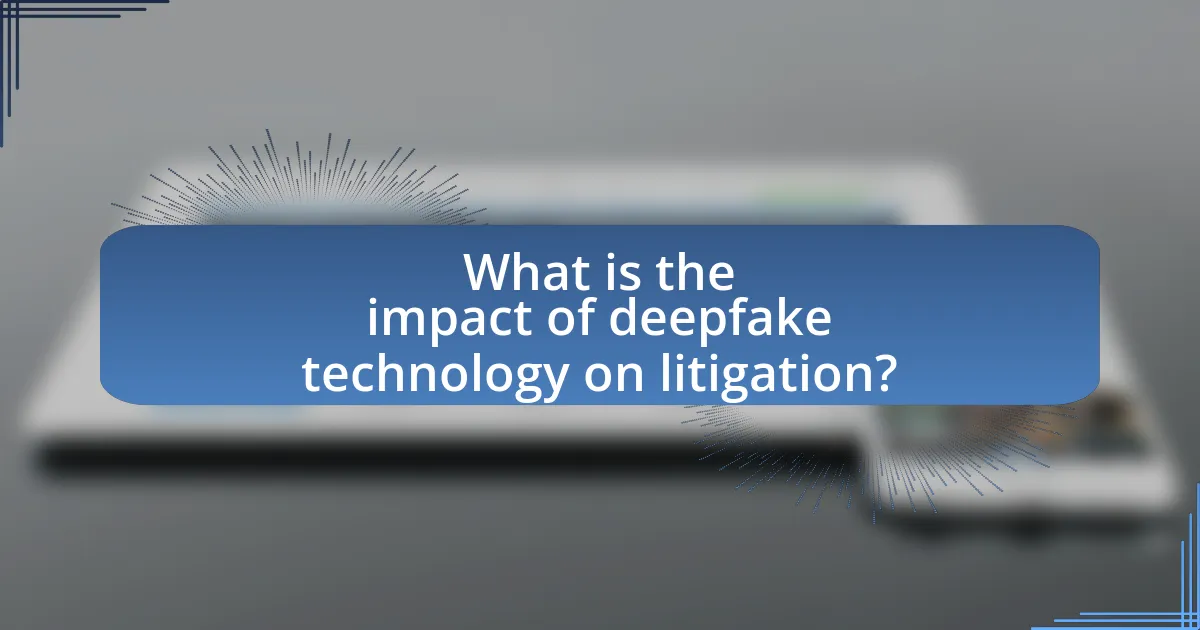
What is the impact of deepfake technology on litigation?
Deepfake technology significantly impacts litigation by complicating the verification of evidence and witness credibility. The ability to create realistic but fabricated audio and video content can lead to challenges in distinguishing genuine evidence from manipulated material, potentially undermining the integrity of court proceedings. For instance, a study published in the journal “Nature” highlights that deepfake detection remains a significant hurdle, with detection rates often falling below 50% for advanced deepfakes. This technological advancement raises concerns about the authenticity of testimonies and the reliability of visual evidence, necessitating new legal frameworks and forensic techniques to address these challenges effectively.
How does deepfake technology challenge traditional legal frameworks?
Deepfake technology challenges traditional legal frameworks by creating realistic but fabricated audio and visual content that can mislead individuals and institutions. This technology complicates the enforcement of laws related to defamation, privacy, and intellectual property, as it blurs the lines between genuine and manipulated content. For instance, in 2020, a report by the Brookings Institution highlighted that deepfakes could undermine trust in media and evidence, making it difficult for courts to ascertain the authenticity of video and audio evidence. As a result, existing legal standards for evidence and liability may need to be re-evaluated to address the unique challenges posed by deepfakes, including the potential for misuse in fraud and misinformation campaigns.
What are the implications of deepfakes for evidence authenticity?
Deepfakes significantly undermine evidence authenticity by creating realistic but fabricated audio and visual content that can mislead courts and juries. The proliferation of deepfake technology raises concerns about the reliability of video and audio evidence, as it becomes increasingly difficult to distinguish between genuine and manipulated content. For instance, a study by the University of California, Berkeley, found that deepfake detection methods struggle to keep pace with advancements in deepfake creation, highlighting the challenges in verifying evidence authenticity in legal contexts. This erosion of trust in digital evidence can lead to wrongful convictions or acquittals, ultimately impacting the integrity of the judicial system.
How can deepfakes affect witness credibility in court?
Deepfakes can significantly undermine witness credibility in court by creating realistic but fabricated audio and video evidence that can mislead juries and judges. The presence of deepfake technology raises doubts about the authenticity of genuine witness testimonies, as jurors may struggle to distinguish between real and manipulated content. Research indicates that the ability to produce convincing deepfakes has increased, with studies showing that even trained professionals can be deceived by high-quality deepfake videos. This erosion of trust in visual evidence can lead to wrongful convictions or acquittals, as the reliability of witness accounts becomes questionable in the eyes of the court.
What are the potential legal consequences of deepfake usage?
The potential legal consequences of deepfake usage include defamation, fraud, and violations of privacy rights. Defamation occurs when deepfakes are used to create false representations that harm an individual’s reputation, leading to civil lawsuits. Fraud can arise when deepfakes are employed to deceive individuals or organizations for financial gain, which may result in criminal charges. Additionally, deepfake technology can infringe on privacy rights by misappropriating an individual’s likeness without consent, potentially leading to legal action under privacy laws. These consequences are increasingly recognized in legal frameworks, as jurisdictions adapt to address the challenges posed by this technology.
What types of cases are most likely to involve deepfake technology?
Cases most likely to involve deepfake technology include defamation, fraud, and identity theft. In defamation cases, deepfakes can create misleading videos or audio that damage an individual’s reputation. Fraud cases may utilize deepfakes to impersonate individuals for financial gain, as seen in scams where fake videos of executives are used to authorize transactions. Identity theft cases can involve deepfake technology to create false identities or manipulate personal information, leading to significant legal implications. The increasing sophistication of deepfake technology raises concerns about its potential misuse in these legal contexts.
How can deepfakes lead to defamation or fraud claims?
Deepfakes can lead to defamation or fraud claims by creating misleading representations of individuals that can damage their reputation or mislead others for financial gain. For instance, a deepfake video could falsely depict a person making defamatory statements, which could result in reputational harm and legal action for defamation. Additionally, deepfakes can be used in scams, such as impersonating a CEO to authorize fraudulent transactions, leading to claims of fraud. The rise of deepfake technology has been documented in various studies, highlighting its potential for misuse in legal contexts, thereby increasing the likelihood of litigation related to defamation and fraud.
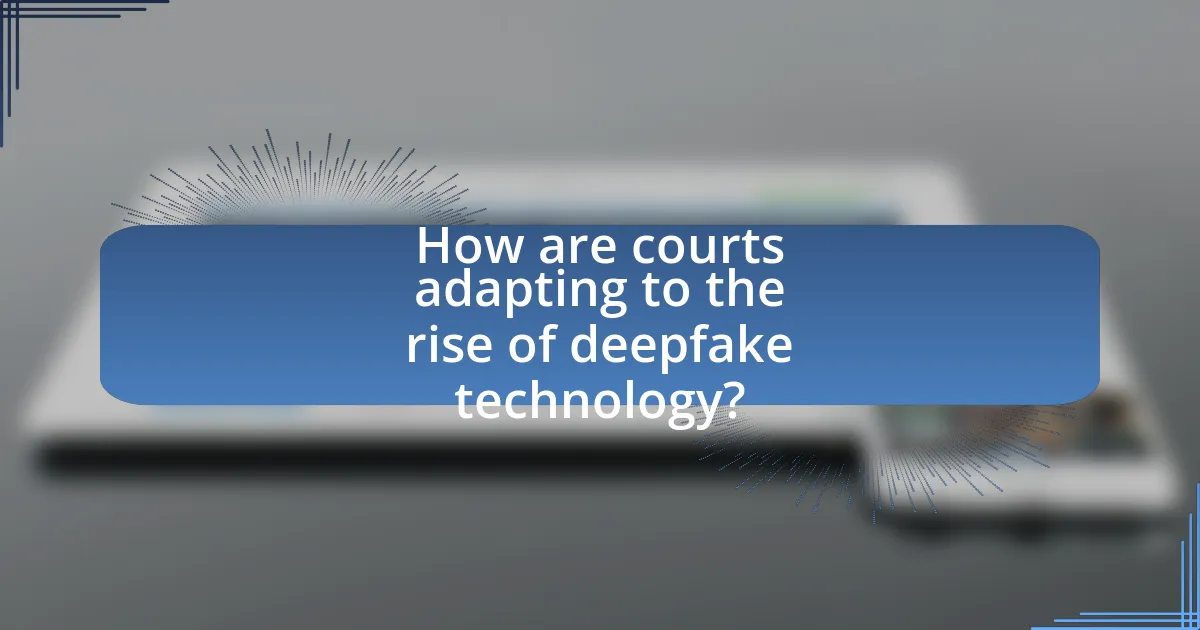
How are courts adapting to the rise of deepfake technology?
Courts are adapting to the rise of deepfake technology by implementing new evidentiary standards and enhancing forensic analysis capabilities. Legal systems are increasingly recognizing the potential for deepfakes to mislead juries and affect case outcomes, prompting judges to establish protocols for evaluating the authenticity of digital evidence. For instance, some jurisdictions are incorporating expert testimony on digital forensics to assess the validity of video and audio evidence, ensuring that juries receive accurate information. Additionally, legislative measures are being introduced to address the misuse of deepfakes, with laws aimed at penalizing malicious use and protecting individuals from defamation and fraud. These adaptations reflect a proactive approach to maintaining the integrity of the judicial process in the face of evolving technological challenges.
What measures are being implemented to verify evidence in court?
Measures being implemented to verify evidence in court include the use of advanced forensic techniques, digital authentication tools, and expert testimony. Forensic techniques, such as audio and video analysis, help identify alterations or manipulations in evidence, particularly relevant in cases involving deepfake technology. Digital authentication tools, like blockchain, provide secure verification of the origin and integrity of digital evidence. Expert testimony from specialists in digital forensics further supports the validation process by offering insights into the authenticity and reliability of the evidence presented. These measures are crucial in ensuring that courts can accurately assess the validity of evidence in an era increasingly influenced by sophisticated digital manipulations.
How are judges and juries being educated about deepfake technology?
Judges and juries are being educated about deepfake technology through specialized training programs and legal seminars. These educational initiatives focus on the identification and implications of deepfakes in legal contexts, emphasizing the potential for misinformation and its impact on evidence. For instance, organizations like the National Judicial College offer courses that include modules on digital evidence, including deepfakes, to enhance judicial understanding. Additionally, legal conferences often feature discussions on the challenges posed by deepfake technology, equipping jurors and judges with the knowledge to critically assess such evidence in court.
What role do forensic experts play in deepfake litigation?
Forensic experts play a critical role in deepfake litigation by providing specialized analysis to determine the authenticity of digital content. Their expertise allows them to identify manipulated media through techniques such as digital forensics, which includes examining metadata, analyzing pixel-level discrepancies, and employing machine learning algorithms to detect inconsistencies. For instance, a study published in the journal “IEEE Transactions on Information Forensics and Security” highlights that forensic analysis can achieve over 90% accuracy in identifying deepfake videos, thereby reinforcing the validity of their findings in legal contexts. This capability is essential for courts to assess evidence accurately and make informed decisions regarding cases involving deepfake technology.
How are legal professionals preparing for deepfake-related cases?
Legal professionals are preparing for deepfake-related cases by enhancing their understanding of digital forensics and investing in advanced detection technologies. They are collaborating with tech experts to develop methodologies for identifying deepfakes, as evidenced by the increasing number of legal seminars and workshops focused on this emerging issue. Additionally, legal practitioners are advocating for clearer regulations and guidelines to address the challenges posed by deepfakes in court, reflecting a proactive approach to adapting to the evolving landscape of digital evidence.
What skills are essential for lawyers dealing with deepfake evidence?
Lawyers dealing with deepfake evidence must possess strong analytical skills, technical proficiency, and a solid understanding of digital forensics. Analytical skills enable lawyers to critically evaluate the authenticity of evidence, while technical proficiency allows them to navigate the complexities of deepfake technology. A solid understanding of digital forensics is essential for effectively gathering, preserving, and presenting evidence in court. These skills are crucial as deepfake technology continues to evolve, posing challenges in verifying the legitimacy of visual and audio content in legal proceedings.
How can legal teams effectively counter deepfake claims?
Legal teams can effectively counter deepfake claims by employing advanced forensic analysis techniques to verify the authenticity of digital evidence. These techniques include using software that detects inconsistencies in video and audio files, such as pixel anomalies or unnatural speech patterns, which are often indicative of deepfake technology. For instance, a study by the University of California, Berkeley, demonstrated that machine learning algorithms could identify deepfakes with over 90% accuracy by analyzing frame-by-frame discrepancies. Additionally, legal teams should gather corroborating evidence from credible sources, such as eyewitness accounts or original recordings, to support their case against deepfake claims. This multi-faceted approach enhances the legal team’s ability to challenge the validity of deepfake content effectively.
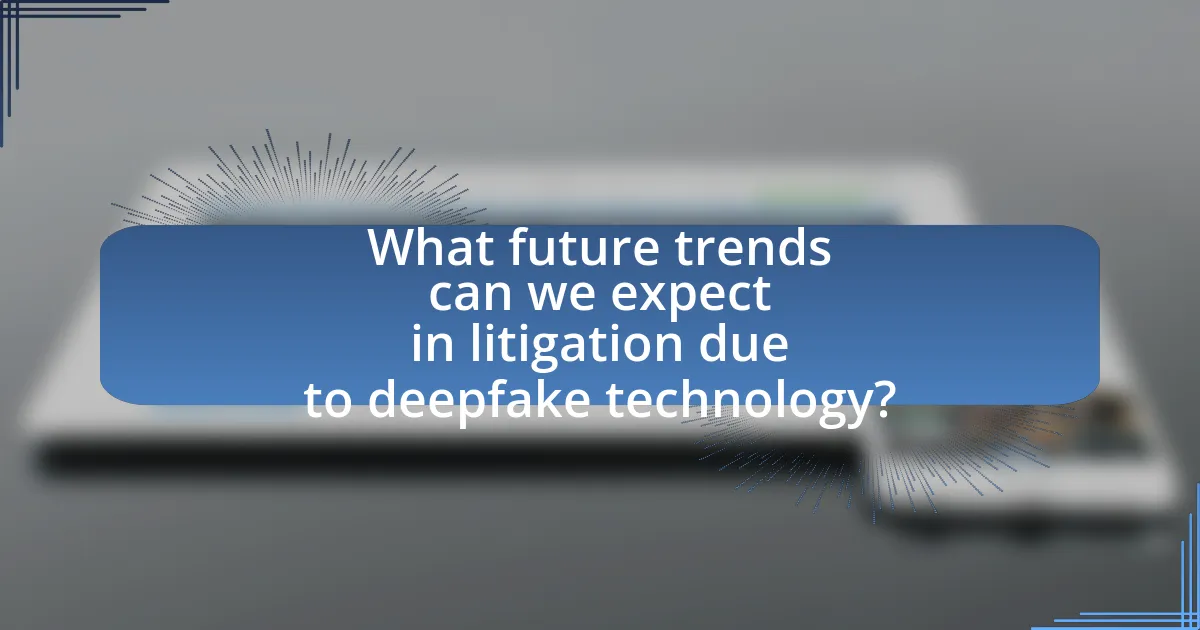
What future trends can we expect in litigation due to deepfake technology?
Future trends in litigation due to deepfake technology will likely include increased challenges in proving authenticity of evidence and a rise in defamation and fraud cases. As deepfake technology becomes more sophisticated, courts may see a surge in disputes over the validity of video and audio evidence, necessitating the development of new forensic techniques to detect alterations. Additionally, legal frameworks may evolve to address the unique challenges posed by deepfakes, leading to more stringent regulations and potential liability for creators and distributors of deepfake content. This trend is supported by the growing number of reported incidents involving deepfakes in legal contexts, highlighting the urgent need for legal adaptation.
How might legislation evolve to address deepfake challenges?
Legislation may evolve to address deepfake challenges by implementing stricter regulations on the creation and distribution of deepfake content. As deepfakes pose significant risks to privacy, misinformation, and defamation, lawmakers could introduce laws that require clear labeling of manipulated media and impose penalties for malicious use. For instance, California enacted a law in 2019 that criminalizes the use of deepfakes to harm or defraud individuals, demonstrating a legislative response to the potential dangers of this technology. Additionally, international cooperation may be necessary to create a unified legal framework, as deepfake technology transcends borders and requires a coordinated approach to effectively mitigate its risks.
What potential regulations could be introduced to combat deepfake misuse?
Potential regulations to combat deepfake misuse could include mandatory labeling of deepfake content, criminal penalties for malicious use, and the establishment of a regulatory body to oversee deepfake technology. Mandatory labeling would require creators to disclose when content has been altered, enhancing transparency and accountability. Criminal penalties could deter individuals from using deepfakes for fraud, harassment, or misinformation, as seen in existing laws against identity theft and defamation. Establishing a regulatory body would provide a framework for monitoring deepfake technology, similar to how financial institutions are regulated to prevent fraud. These measures aim to protect individuals and society from the harmful effects of deepfake misuse.
How can international law adapt to the global nature of deepfakes?
International law can adapt to the global nature of deepfakes by establishing comprehensive legal frameworks that address the unique challenges posed by this technology. These frameworks should include clear definitions of deepfakes, regulations on their creation and distribution, and mechanisms for accountability that span multiple jurisdictions. For instance, the European Union’s Digital Services Act aims to regulate harmful content online, which could serve as a model for international agreements that specifically target deepfake misuse. Additionally, international cooperation among nations is essential to enforce laws effectively, as deepfakes often cross borders, complicating jurisdictional issues. By creating standardized definitions and collaborative enforcement strategies, international law can better protect individuals and societies from the potential harms of deepfakes.
What best practices should legal professionals adopt regarding deepfakes?
Legal professionals should adopt a proactive approach to deepfakes by implementing rigorous verification processes for digital evidence. This includes utilizing advanced forensic tools to analyze the authenticity of video and audio materials, as deepfakes can significantly impact the integrity of evidence in litigation. According to a study by the University of California, Berkeley, deepfake detection technologies have improved, with some systems achieving over 90% accuracy in identifying manipulated content. Legal professionals must also stay informed about evolving legislation and case law related to deepfakes, ensuring compliance and understanding the implications for their cases. Additionally, they should educate clients about the risks associated with deepfakes, fostering awareness and preparedness in potential legal disputes.
How can lawyers stay informed about advancements in deepfake technology?
Lawyers can stay informed about advancements in deepfake technology by subscribing to legal technology journals, attending industry conferences, and participating in specialized training programs. Legal technology journals such as the “Harvard Journal of Law & Technology” frequently publish articles on emerging technologies, including deepfakes, providing insights into their implications for the legal field. Additionally, conferences like the “International Conference on Cyberlaw, Cybercrime & Cybersecurity” offer sessions focused on deepfake technology, allowing lawyers to engage with experts and peers. Specialized training programs, such as those offered by the American Bar Association, can equip lawyers with the necessary knowledge to understand and address the challenges posed by deepfakes in litigation.
What strategies can be employed to safeguard against deepfake-related risks?
To safeguard against deepfake-related risks, organizations can implement a combination of technological solutions, legal frameworks, and public awareness initiatives. Technological solutions include the use of deepfake detection software, which employs machine learning algorithms to identify manipulated media, thereby reducing the likelihood of misinformation. Legal frameworks can be strengthened by enacting laws that specifically address the creation and distribution of deepfakes, providing legal recourse for victims. Public awareness initiatives educate individuals about the existence and potential dangers of deepfakes, empowering them to critically evaluate media content. These strategies collectively enhance resilience against the threats posed by deepfake technology, as evidenced by ongoing research indicating that proactive measures can significantly mitigate the impact of misinformation in digital environments.

